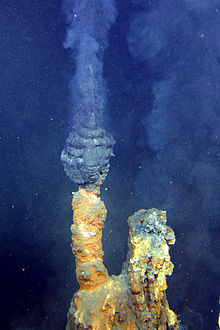Prebiotic ammonia synthesis
The term prebiotic ammonia synthesis is understood to mean scientific models and theories about the formation of ammonia without the involvement of living organisms, especially on the still inanimate primordial earth (from Latin prae- , “before” and Greek bios , “life”).
Ammonia from volcanic gases
The formation of ammonia and organic nitrogen compounds through chemical evolution was initially explained with the help of the primordial soup theory and the Miller-Urey experiment , whereby the ammonia gas required should come from volcanic exhalations on the primordial earth.
Ammonia from the iron-sulfur world of submarine volcanoes
In the context of the model of the iron-sulfur world of Günter Wächtershäuser was detected 2002/2003 by Weigand and Kreizer in Jena, that ammonia by a chemical reaction of molecular nitrogen in an aqueous suspension of freshly precipitated iron (II) sulfide to ammonia , Hydrogen gas and pyrite can react.
Weigand and Kreiser took up the criticism of Miller, according to which the amounts of methane, ammonia and hydrogen he used in the primordial soup experiment were set too high - the amount of organic products was significantly lower when the concentrations of these substances assumed by geologists was used in the primordial atmosphere of the earth. Weigand and Kreiser, on the other hand, showed that their experiment could also run at atmospheric pressure, without enzymes and at temperatures of around 80 ° C - conditions that prevail in the iron-sulfur world of deep-sea volcanoes.
The driving force of the reaction is the partial oxidation of iron (II) sulfide (FeS) and hydrogen sulfide (H 2 S) to pyrite ( iron disulfide , FeS 2 ) and hydrogen gas (H 2 ).
The nitrogen molecules dock on the surface of freshly precipitated iron sulfide particles, which weakens the nitrogen-nitrogen triple bond so that hydrogen ions can react with the nitrogen atoms to form ammonia - similar to the surface of the industrial catalysts used in the Haber-Bosch process Ammonia production.
See also
Individual evidence
- ↑ M. Dörr, J. Käßbohrer, R. Grunert, G. Kreisel, WA Brand, RA Werner, H. Geilmann, C. Apfel, C. Robl, W. Weigand: A possible prebiotic formation of ammonia from molecular nitrogen on iron sulfide surfaces . Angewandte Chemie, Vol. 115, pp. 1579 - 1581, 2003 ( PDF file; 96 kB )
- ^ FAZ of April 16, 2003

